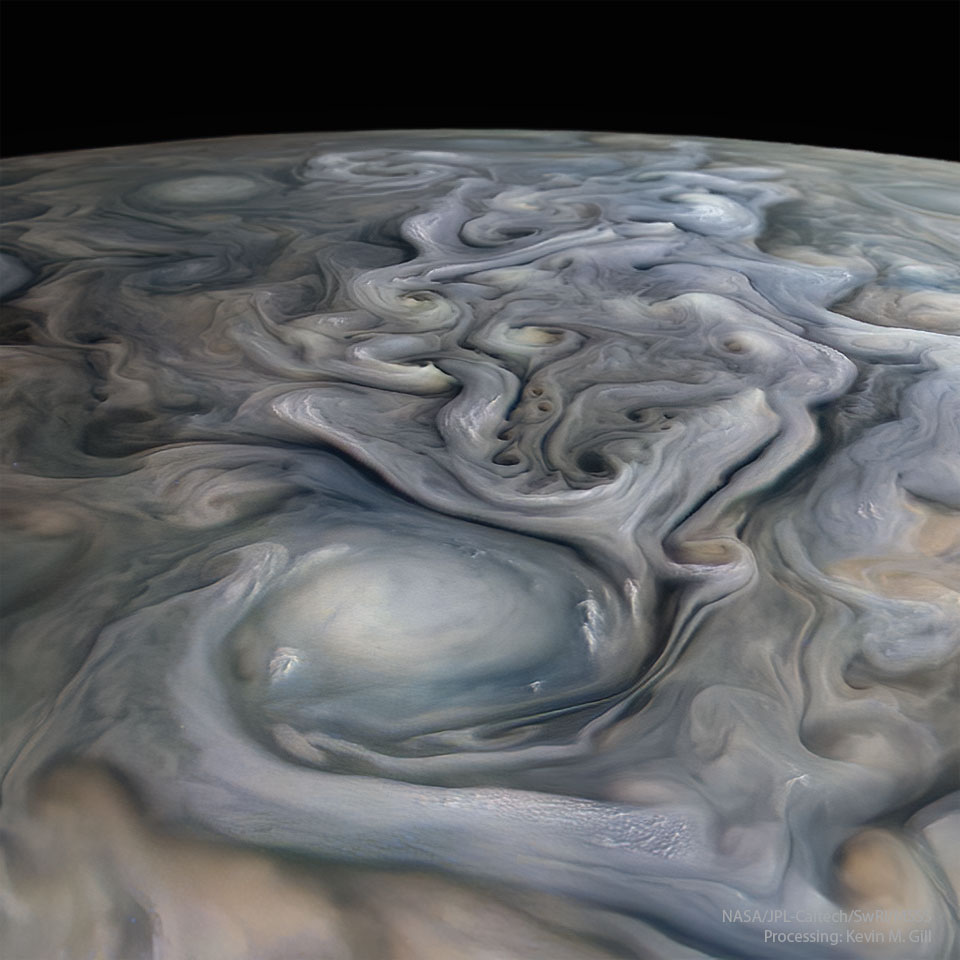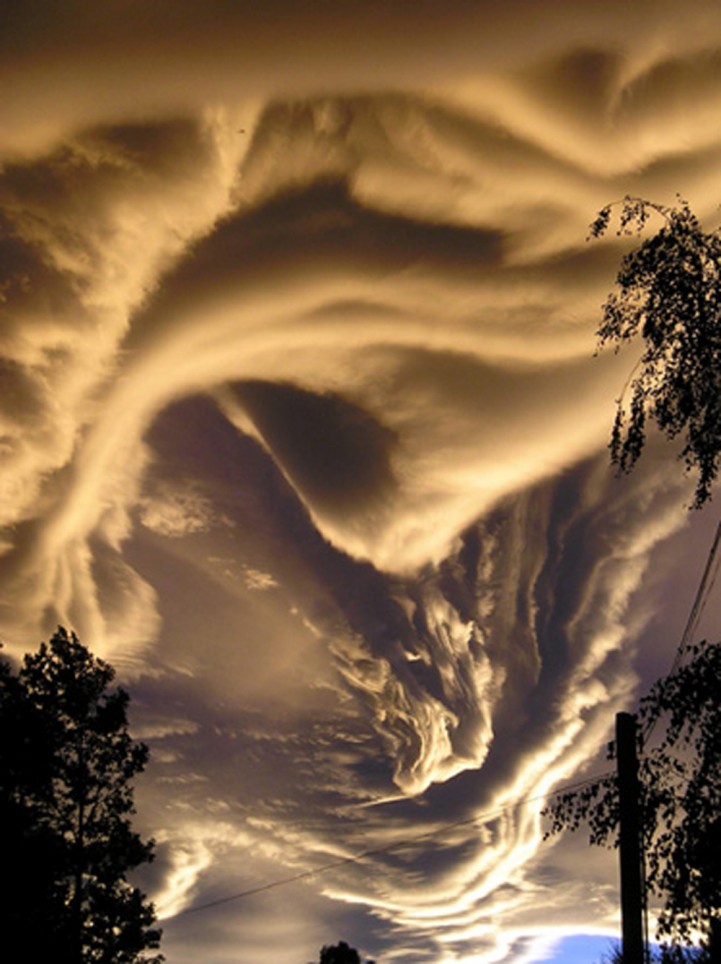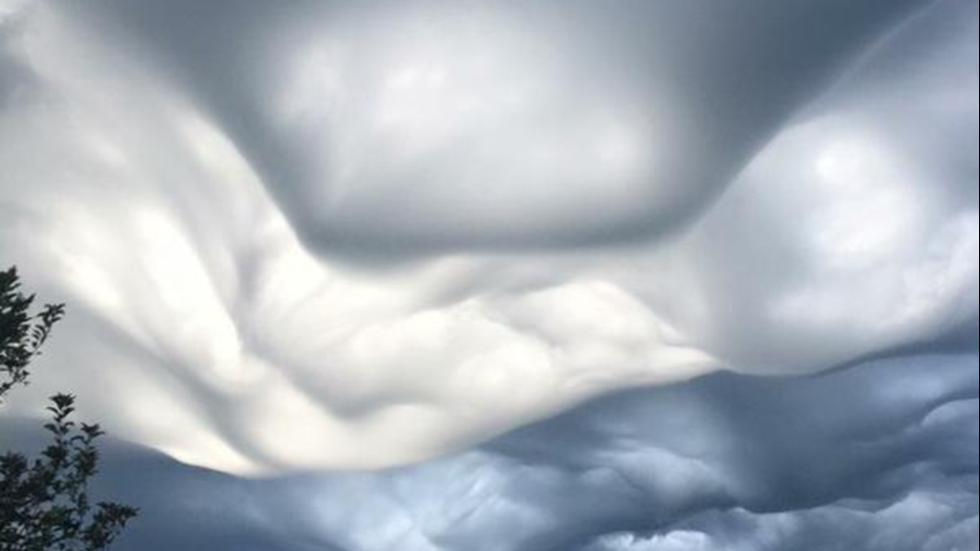Page 1 of 1
APOD: Jupiter's Swirls from Juno (2023 May 23)
Posted: Tue May 23, 2023 4:08 am
by APOD Robot
 Jupiter's Swirls from Juno
Explanation:
Jupiter's Swirls from Juno
Explanation: Big storms are different on Jupiter. On Earth, huge
hurricanes and colossal
cyclones are centered on regions of low pressure, but on Jupiter, it is the high-pressure, anti-cyclone storms that are the largest. On
Earth, large storms can last weeks, but on
Jupiter they can last years. On Earth, large storms can be as large as a country, but on Jupiter, large storms can be as large as planet Earth. Both types of storms are known to exhibit
lightning. The
featured image of Jupiter's clouds was composed from images and data captured by the robotic
Juno spacecraft as it
swooped close to the massive planet in August 2020. A swirling
white oval is visible nearby, while numerous smaller
cloud swirls extend into the distance. On Jupiter, light-colored
clouds are usually higher up than dark clouds. Despite their differences, studying storm clouds on distant Jupiter provides
insights into storms and other weather patterns on
familiar Earth.Â
Re: APOD: Jupiter's Swirls from Juno (2023 May 23)
Posted: Tue May 23, 2023 5:27 am
by RocketRon
Intriguing image !
Do we have a handle on what these 'clouds' are actually composed of ?
Re: APOD: Jupiter's Swirls from Juno (2023 May 23)
Posted: Tue May 23, 2023 5:33 am
by daddyo
And are the lower clouds darker due to shadowing by the higher clouds?
Has a 3D stereo image been done of Jupiter’s clouds? That might look amazing to actually see the cloud depth.
Re: APOD: Jupiter's Swirls from Juno (2023 May 23)
Posted: Tue May 23, 2023 5:46 am
by Ann
RocketRon wrote: ↑Tue May 23, 2023 5:27 am
Intriguing image !
Do we have a handle on what these 'clouds' are actually composed of ?
Umm... Ammonia? Methane? Some water?
Anyway....
This spectacle looks otherworldly! And, of course, it is.
What do the corresponding "worldly" storms look like? I really recommend
this page if you want to sneak a peek! Let me show you a preview:
Of course, if you think that the Jovian clouds look just
too different from the Earth clouds, it may have at least
something to do with scale (and just possibly resolution). The storm clouds on Jupiter are just so, so much larger than the ones on Earth.
(And, yeah... Storm clouds on Earth are low pressure zones, but on Jupiter they are high pressure zones... whatever...)
Ann
Re: APOD: Jupiter's Swirls from Juno (2023 May 23)
Posted: Tue May 23, 2023 8:10 am
by Lasse H
"On Jupiter, light-colored clouds are usually higher up than dark clouds."
The same goes for earth, I think. Isn't just because clouds higher up get more light than the ones deeper down?
- Which are in more shadow than the ones on top, of course.
As simple as that?
Re: APOD: Jupiter's Swirls from Juno (2023 May 23)
Posted: Tue May 23, 2023 1:14 pm
by Chris Peterson
Lasse H wrote: ↑Tue May 23, 2023 8:10 am
"On Jupiter, light-colored clouds are usually higher up than dark clouds."
The same goes for earth, I think. Isn't just because clouds higher up get more light than the ones deeper down?
- Which are in more shadow than the ones on top, of course.
As simple as that?
No, the reference is to "lightness" in the sense of actual reflectivity. Clouds on Earth are only made of water droplets, which essentially reflect white light. Clouds on Jupiter are made of gases and droplets of other compounds, and selectively reflect different wavelengths, impacting their color and how bright they appear.
Re: APOD: Jupiter's Swirls from Juno (2023 May 23)
Posted: Tue May 23, 2023 6:32 pm
by orin stepanek
I like todays APOD!


Re: APOD: Jupiter's Swirls from Juno (2023 May 23)
Posted: Tue May 23, 2023 9:09 pm
by johnnydeep
Chris Peterson wrote: ↑Tue May 23, 2023 1:14 pm
Lasse H wrote: ↑Tue May 23, 2023 8:10 am
"On Jupiter, light-colored clouds are usually higher up than dark clouds."
The same goes for earth, I think. Isn't just because clouds higher up get more light than the ones deeper down?
- Which are in more shadow than the ones on top, of course.
As simple as that?
No, the reference is to "lightness" in the sense of actual reflectivity. Clouds on Earth are only made of water droplets, which essentially reflect white light. Clouds on Jupiter are made of gases and droplets of other compounds, and selectively reflect different wavelengths, impacting their color and how bright they appear.
With the conclusion being that the higher clouds are preferentially made of different compounds than lower clouds, and THAT's why the higher clouds are brighter in appearance, right?
[ PS - why do I keep getting logged out lately? <grrr> ]
Re: APOD: Jupiter's Swirls from Juno (2023 May 23)
Posted: Tue May 23, 2023 9:59 pm
by zendae
Jupiter has nothing on Earth when it comes to clouds...
Re: APOD: Jupiter's Swirls from Juno (2023 May 23)
Posted: Wed May 24, 2023 2:55 am
by longtry
Today's image is so impressive I thought it was a 3D model before reading that it was actually taken by Juno. All of the spacecraft's photos that I've seen before don't have a depth of this level, so it stands out as a pleasant surprise.
Re: APOD: Jupiter's Swirls from Juno (2023 May 23)
Posted: Wed May 24, 2023 7:22 am
by Rauf
zendae wrote: ↑Tue May 23, 2023 9:59 pm
Jupiter has nothing on Earth when it comes to clouds...
Are these Earth's clouds?
Re: APOD: Jupiter's Swirls from Juno (2023 May 23)
Posted: Wed May 24, 2023 8:56 pm
by johnnydeep
Rauf wrote: ↑Wed May 24, 2023 7:22 am
zendae wrote: ↑Tue May 23, 2023 9:59 pm
Jupiter has nothing on Earth when it comes to clouds...
...
Are these Earth's clouds?
Yes. Unusual ones.

But I wouldn't count Jupiter out, since we haven't seen its clouds from
underneath them yet!
Re: APOD: Jupiter's Swirls from Juno (2023 May 23)
Posted: Sat May 27, 2023 1:56 pm
by VictorBorun
daddyo wrote: ↑Tue May 23, 2023 5:33 am
And are the lower clouds darker due to shadowing by the higher clouds?
Has a 3D stereo image been done of Jupiter’s clouds? That might look amazing to actually see the cloud depth.
a stereo mission to Jupiter is need!
What puzzles me is that while wiki says the walls and canyons we see between next companions are not looming high at all, just
a few tens of kilometers above the visible clouds
a white oval is typically huge, about
the size of Earth
Is it the low sun that tricks us into seeing taller-than-life cloud castles?
 Jupiter's Swirls from Juno
Jupiter's Swirls from Juno





